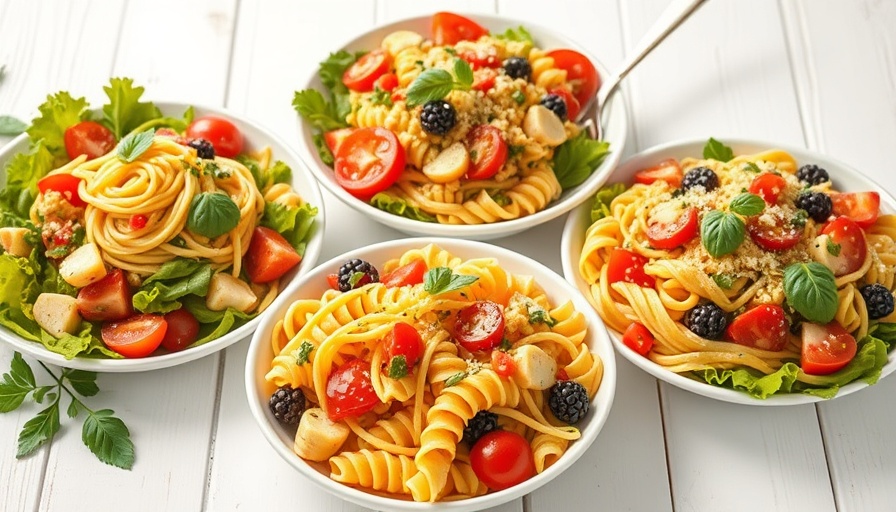
Light and Healthy Summer Pasta Ideas: A Nutritional Makeover
With summer rolling in, it's the perfect time to enjoy light and healthy meals that not only tantalize the taste buds but also align with your nutritional goals. Pastas can be transformed into vibrant dishes brimming with fresh ingredients and lighter sauces, rejuvenating the age-old comfort food into something that's ideal for warm weather.
A Summertime Twist on Pasta
Contrary to the comforting associations we often have with pasta in colder months, there are numerous summer pasta recipes that showcase fresh produce, lean proteins, and zesty flavors. From Italian classics to innovative creations, here are some delightful options that cater to various dietary preferences.
1. Italian Chicken Pasta Salad
This Mediterranean-inspired Italian chicken pasta salad is a colorful dish bursting with flavor and nutrition. Each serving is packed with 456 calories, 22 grams of protein, and an array of fresh herbs and lemon zest that scream summertime freshness.
2. Prawn Orzo with Sun-Dried Tomatoes
A luscious combination of juicy prawns and tangy sun-dried tomatoes makes this orzo pasta a winner for seafood lovers. At 676 calories and with a remarkable protein count of 36 grams, it's perfect for those seeking a satisfying yet light meal option.
3. Zucchini Noodles with Asian Flair
For those exploring alternative takes on traditional pasta, try this chicken zucchini pasta featuring spiralized zucchini noodles. Infused with Asian flavors like soy sauce and ginger, it’s a light yet fulfilling dish that offers a new twist on a classic.
Why Choose Lighter Pasta Dishes in Summer?
As the temperatures rise, many individuals look for ways to adjust their diets to reflect the season. Lighter pasta dishes minimize heavy sauces and carbs while maximizing fresh produce, hence offering a cooling, refreshing meal. By incorporating seasonal vegetables, protein sources, and whole grains, you not only enhance flavor but also constitute a healthier meal.
Consider these lighter options:
Cherry Tomato Pasta with Basil and Chicken: Delightfully fragrant and colorful, this dish balances protein with fresh garden vegetables.
Basil Lemon Pasta: This recipe combines vibrant lemon zest and fresh basil, creating a light sauce full of flavor while being easy on the waistline.
Summer Spaghetti with Garlic and Lemon: Minimally processed ingredients keep this dish bright and exciting.
Embracing Nutritional Value without Compromise
Many believe that revamping pasta dishes for healthier versions may sacrifice taste. Contrary to this misconception, integrating fresh herbs, zesty citrus, and light proteins can invigorate your pasta experience. Enjoying dishes packed with vegetables not only enhances your meals but also supplies essential nutrients, fiber, and antioxidants crucial for health.
Tips for Making Healthier Pasta Choices
Here are some practical tips for creating your refreshing summer pasta:
Opt for Whole Grains: Choosing whole grain pasta increases fiber intake and offers a more substantial satiety level.
Incorporate Vegetables: Make veggies the star of your dish by adding a variety of colors and types to maximize flavor and nutrients.
Control Portions: Focus on better portion management by using smaller plates and bowls, helping you to enjoy your meals without overeating.
Final Thoughts on Summer Pasta Ideas
Summer is a great time to experiment with lighter, fresher pasta dishes that maintain flavor while promoting nutritional goals. As you explore these recipes, remember that cooking should be a joyful journey. Enjoy the process of discovering new flavors that celebrate the season.
By embracing these light and healthy summer pasta ideas, not only will you satiate your cravings, but you’ll also invigorate your health journey. So gather your ingredients, invite friends over, and turn mealtime into a celebration of summer!
Take your health journey a step further by experimenting with these delicious light pasta recipes today!
 Add Row
Add Row  Add
Add 







Write A Comment